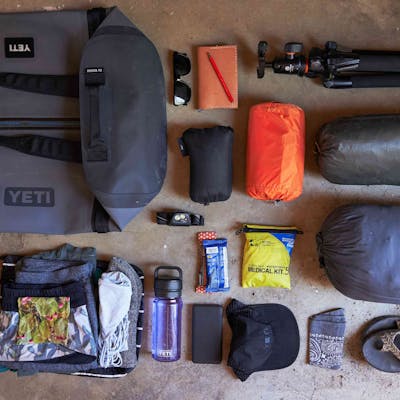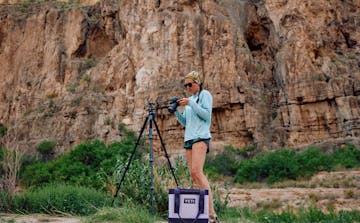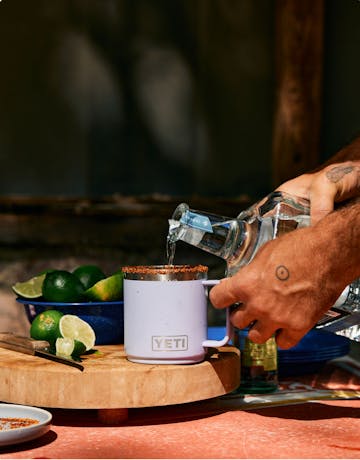
Every year I spend a few exhilarating weeks storm chasing and photographing extreme weather on the plains, but until recently, that was the extent of my travels in Texas. Big Bend had long been high on my list of places to visit, but since it’s so far removed from most routes, I never included it on any of my numerous road trips through the Southwest. This spring I crafted a dream itinerary around a multi-day canoe trip on the Rio Grande, with stops in a handful of small towns on either side of the Big Bend area. From stellar meals by the river to marveling at the Milky Way twinkling in the sky, this adventure was a warm welcome to new territory in the Lone Star State.
Beyond photographing desert scenery, Big Bend was on my radar due to its designation as an International Dark Sky Reserve. Not only are dark sky parks incredible places to set up for astrophotography and timelapses, but they’re generally well off the beaten path, thus giving me something I crave: time to be still and soak it all up.
WHEN TO GO: SPRING BLOOMS
AND STARGAZING
The trip was planned around the new moon for astrophotography opportunities, and as luck would have it, the beginning of the Milky Way season coincides with prime weather for desert camping. I am especially fascinated by the change of seasons in the desert, as it helps illustrate just how much life exists (and persists) in these seemingly inhospitable regions.
I flew in via Austin, which is a seven-hour drive to the Big Bend area. (The smaller El Paso International Airport is just a five-hour drive to Big Bend, and right off of Interstate-10.) I hadn’t been monitoring the wildflower forecasts in Texas, so I was delighted to have also timed my visit during a spring bloom. After cruising past fields of wildflowers in Texas Hill Country, our group caravanned south to Marathon and cut through the Chihuahuan desert, which was unusually verdant after several late winter storms.
WHAT TO DO: FLOAT THE RIO
GRANDE
I’m a seasoned backpacker and I live out of my truck camper most of the year documenting my adventures in the Western U.S., but river trips have been a relatively newer outdoor pursuit. I’m always looking for lesser-traveled routes that cater to beginners, and with its mellow flow and spectacular scenery, this particular stretch of the Rio Grande checked every box. We booked our guided trip with Far West Texas Outfitters, who offer a handful of incredible multi-day adventures on the Rio Grande, as well as the Pecos and Devils Rivers. We put in at Heath Canyon Ranch, a quiet spot across the river from the abandoned mining community of La Linda. There weren’t any rapids on our route; rather, the river was so shallow in spots, we had to hop out and drag our canoes several times a day. We didn’t see another party for three days, so aside from turkey vultures and a herd of boisterous burros, we had the entire canyon to ourselves.
When I took a dip near camp at the end of our first day, I closed my eyes and reveled in the blissful sensation of cool water rushing over my skin. This meditative moment was quickly interrupted by the bray of a nearby burro, whose guttural honking echoed off the canyon walls around me. I burst out laughing, because this was the last thing I expected, and yet somehow everything I had hoped for on this trip.
WHAT TO PACK: BE SMART AND
GO LIGHT
Whether I’m going on a float trip or flying halfway across the world, I’ve learned to balance minimalism and preparedness when it comes to packing. I opt for clothes that can be worn on multiple occasions and I consider what camera lenses I could live without. Since this was a float trip, I planned to use my waterproof bags.
Far West Texas Outfitters will bring camp gear upon request, but I chose to pack my lightweight backpacking setup, which includes the Big Agnes Tiger Wall UL3 tent, a Big Agnes Air Core Ultra air chamber sleeping pad, a Big Agnes Lost Ranger 15-degree sleeping bag, and a Nemo Fillo inflatable camp pillow. When it comes to sun protection, my hat is the San Diego Hat Company’s packable El Campo hat, which has a five-inch brim. A pair of classic Chacos Z/2 water sandals were the only shoes I packed, and I brought loose cotton clothes and a Patagonia Micro Puff Hoody jacket for hanging out at camp. I packed my camp gear in the Panga® 75L Waterproof Duffel, plus my tripod, packing cubes filled with clothes and several more essentials, including a small first aid kit, a headlamp and a journal. I used a Panga® 28L Waterproof Backpack for my camera gear, along with other items I wanted easy access to, like sunscreen and snacks. For getting around town by vehicle and photographing the stars, I loaded a number of items in the Camino® 20 Carryall Tote bag, including my camera cubes, a water bottle, snacks, a few extra layers, a headlamp and a portable charge pack.
WHAT TO EAT: STEAKS BY THE
RIVER & CACTUS COCKTAILS
We enjoyed top-notch camp cooking thanks to our guides, Mike Naccarato and Sage Keith, who run Far West Texas Outfitters. When you hire guides, not only do you learn more about the history and ecology of the regions you’re exploring, but their culinary prowess is typically as impressive as their ability to get you out of hairy situations on the river. On our final night, they served up steak with a side of potatoes smashed in steak fat, salt, pepper, fresh dill, and jalapeño goat cheese. We sipped on red wine until we ran out of firewood, and we spent several more hours staring at the constellations above.
The daytime highs were sweltering when we hauled our canoes out of the river at the end of the float, so we took a breather at the Stillwell Ranch Store for ice cream sandwiches and cold drinks before continuing to Terlingua. In Terlingua, The Starlight Theater has some of the best prickly pear margaritas in the state, and the restaurant’s mesquite smoked barbeque sandwich was everything I hoped it would be. The best breakfast joint in town is easily Espresso Y Poco Mas, which, as its name implies, offers coffee and a little more, like fresh juices to go with your eggs benedict.
LOCAL STOPS: SMALL TOWNS
ALONG THE WAY
Marathon is one of several Big Bend access points, with everything from the hip V6 Coffee Bar to stargazing parties at the Marathon Motel & RV Park. Farther east along U.S. Route 90 is the town of Alpine, which offers a full range of services and plenty of West Texas charm. Big Bend Saddlery sells semi-custom hats and an assortment of gifts, and I couldn’t resist walking through the tack section and inhaling the intoxicating smell of fresh leather.
Situated between Big Bend Ranch State Park and Big Bend National Park, Terlingua is the perfect place to recharge after a trip on the Rio Grande. Whether it’s lux hotels or RV parks, Terlingua has lodging options for a range of budgets, plus everything from homey Mexican restaurants to classic barbeque joints. Most of the hotels and restaurants are spread out over a few miles with breathtaking views of the Chisos Mountains, but Ivey Road has a cluster of eateries and attractions ideal for exploring by foot, including an abandoned mining town and the aforementioned Starlight Theatre. Right next to the Starlight is the Terlingua Trading Company, which has a wide selection of handcrafted items including rugs, sculptures and locally produced foods.
WHY IT’S SPECIAL: A
SANCTUARY FOR DARK SKIES
The Big Bend International Dark Sky Reserve encompasses parks and communities on both sides of the Rio Grande, and the region is recognized as having some of the darkest skies in the lower 48 states. These areas are designated by the International Dark Sky Association, with the goal of protecting them from light pollution. Not only does this make for amazing stargazing and astrophotography opportunities, but it helps researchers at the nearby McDonald Observatory and encourages local communities to adopt energy-saving lighting practices that help preserve nocturnal environments for plants and animals. Learn more about what makes this place special from a local amateur astronomer.
Hours before dawn on our final day, I slipped out of my tent to photograph the Milky Way. My eyes adjusted to the darkness while I waited for a dreamy single-frame scene: the galaxy sparkling over the Rio Grande with the canyon walls illuminated by the crescent moon. I grabbed my tripod and waded into a shallow section of the river about 50 yards from camp, and every one of my senses was heightened. As I gazed at the glittering night sky, all I could hear was the water gently flowing over the rocks and the occasional chirp from a frog. It blows my mind that places this serene still exist, and they’re available to us all to enjoy.






























